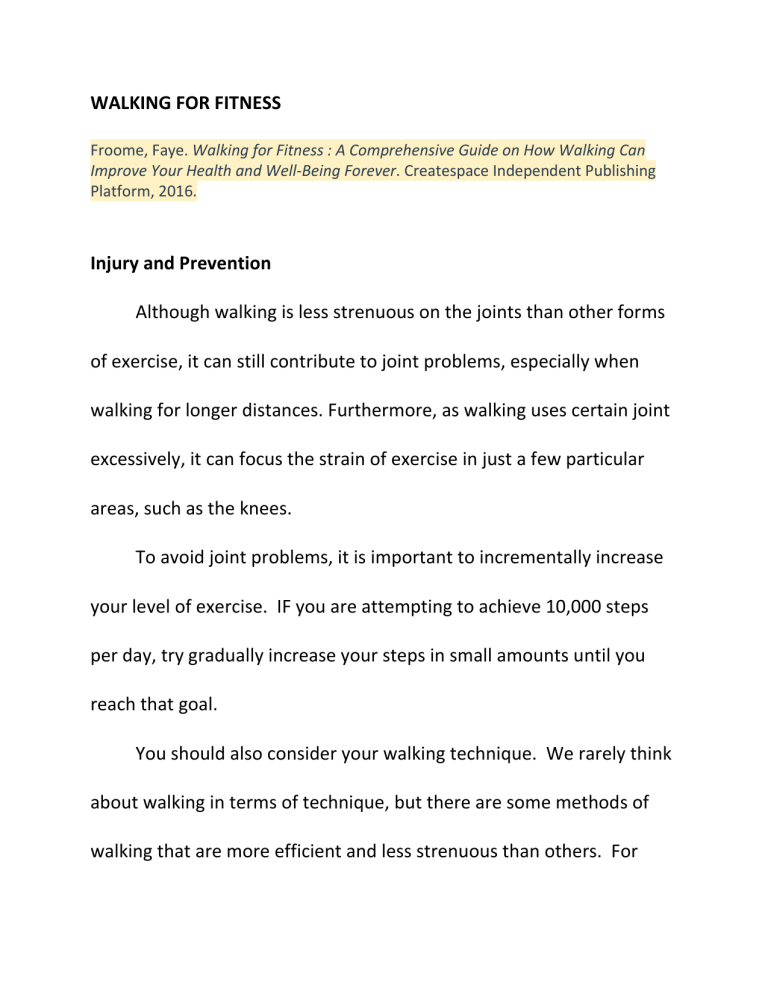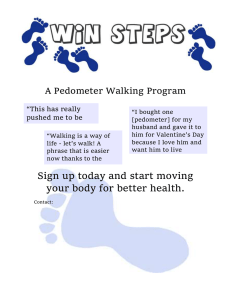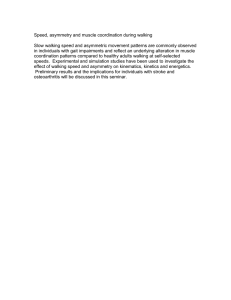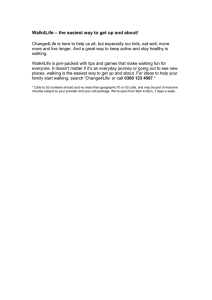
WALKING FOR FITNESS Froome, Faye. Walking for Fitness : A Comprehensive Guide on How Walking Can Improve Your Health and Well-Being Forever. Createspace Independent Publishing Platform, 2016. Injury and Prevention Although walking is less strenuous on the joints than other forms of exercise, it can still contribute to joint problems, especially when walking for longer distances. Furthermore, as walking uses certain joint excessively, it can focus the strain of exercise in just a few particular areas, such as the knees. To avoid joint problems, it is important to incrementally increase your level of exercise. IF you are attempting to achieve 10,000 steps per day, try gradually increase your steps in small amounts until you reach that goal. You should also consider your walking technique. We rarely think about walking in terms of technique, but there are some methods of walking that are more efficient and less strenuous than others. For example, one bad habit when walking is called overpronation. When we walk the sole of our foot rolls against the ground slightly to absorb the impact of our foot against the floor and balance our weight. Overpronation is the habit of rolling the sole of your foot too much when you walk, rather than pushing off the ground for the next step, which causes your weight to be resting on just one side of your foot. Overpronation bends the foot, the calf the knee and can lead to pain and tiredness in these areas. One tell-tale sign of overpronation is the wear of your shoes; if your shoes are worn down on the inner side, you may overpronate. You can correct this habit by paying more attention to your stride as you walk but also consider buying corrective shoes to help adjust your technique. Shoes with straight or semi-curved last can help combat this habit, whilst specific arch supports or motion-control shoes are also useful. Stretching can also help relax the muscles, which can reduce the tendency to overpronate during walking. Under pronation, also known as supination, is the opposite; the foot doesn’t roll enough to absorb the impact, concentrating the impact of collision against the outer areas of the foot, which also stresses the joints in the legs and the feet. If you under-pronate your shoes should be unevenly worn, but on the outer edge. For under pronators, shoes with curved lasts will help correct your bad habit. You should also favor lighter and more flexible material for your shoes as these allow for more motion, making it easier to pronate correctly. If you still find that you have aches and pains in your legs, ankles and feet consider following a walking session, consider the ground you walking upon. Harder uneven or slippery surface are more difficult to walk over and may cause excess strain. Therefore, if possible try to avoid surfaces like concrete or asphalt and instead try and walk over grassy or earthy areas, which absorb the impact of your feet better. The local park is a great place to walk. Likewise avoid walking over sand or snow which requires more effort. Shoes should be replaced on a semi-frequent basis. The protective aspects of shoes will be degraded through prolonged walking, especially the inner support, increasing the risk of injury and other problems. A good ballpark is that shoes should be replaced every 300-500 miles. If you have a hard time calculating how this number equates to steps or distance, it equates to around 6 months of time for someone walking approximately 10,000 steps per day. It can be useful to purchase multiple pairs of walking shoes to rotate between in case on pair gets damaged and can no longer be used( or for any reason is no longer able). Stretching and Warm Up Even though walking is perceived as a milder form of exercise than running or most sports, it can still be useful to stretch and warm up before you have a walking session. Nonetheless, successful stretching and warming up reduces injury and muscle fatigue and can increase performance during a particular session. Warming up increases blood flow to your muscles, this prepares them for greater level of activity. Common warm up stretches for walking include: Calf stretches, hamstring and ankle, groin stretches, and leg swings. Cool Down It’s just as important to cool down as it is to warm up. Cooling down allows your heartbeat and muscles to acclimatize to lower level of activity, which can take several minutes after an intense bout of exercise. If your body changes for intense exercise to sedentary levels of activity too quickly, it can actually stress the body-which is why athletes will often perform a gentle jog after finishing their exercise. To cool down, simply gradually slow your walking over the period of several moments, allowing your heartbeat to decline steadily. Using Weights Many people try and use hand or ankle weights to add resistance to their walking routine. This is NOT recommended. Generally speaking, it is incredibly difficult to add enough weight to build up muscle. However, this is not the reason why it is discouraged by the walking community. The strain weights place upon the ankle as well as the pressure of tendons, ligaments and blood pressure many results in injury. Furthermore, people who wear weights tend to walk slower, removing any calorie burn effect that the extra weight might produce. Instead of adding weights, if you want to make your walk more intense, try walking with a faster pace. Alternatively, introduce weights into your lifestyle in a formal and controlled way in the gym. Resistance training with carefully considered repetitions will build up muscle strength and mass with. More consistency and ease than slapping a few weights around your ankles. Walking Posture When walking it is important to maintain proper posture. Your head should be upright and centered rather than leaning forwards, backwards or towards either of your shoulders. Likewise, your chin should stay parallel to the ground, with a raised or sagged chin putting excess strain on the neck. If you suspect that you do not keep your head upright or your chin parallel to the ground, try balancing a flat a flat object on your head such as a book or folder. If the object stays balanced without any support your head is in the correct position. Your shoulders should be relaxed. As a result of stress or merely chronic bad habits many people raise and tense their shoulder whilst walking. This can contribute to pain and stiffness in the shoulders, but also prevent a natural walking rhythm, making walking harder.



